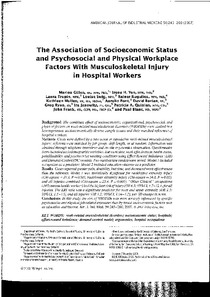The association of socioeconomic status and psychosocial and physical workplace factors with musculoskeletal injury in hospital workers

Gillen, Marion ; Yen, Irene H.
American Journal of Industrial Medicine
2007
50
4
245-260
ergonomics ; hospital ; musculoskeletal diseases ; social status
Musculoskeletal disorders (MSD)
English
Bibliogr.
"The combined effect of socioeconomic, organizational, psychosocial, and physical factors on work-related musculoskeletal disorders (WRMSDs) were studied in a heterogeneous, socioeconomically diverse sample (cases and their matched referents) of hospital workers. Methods Cases were defined by a new acute or cumulative work-related musculoskeletal injury; referents were matched by job group, shift length, or at random. Information was obtained through telephone interviews and on-site ergonomics observation. Questionnaire items included sociodemographic variables, lost work time, work effectiveness, health status, pain/disability, and psychosocial working conditions using Effort Reward Imbalance (ERI) and Demand-Control (DC) models. Two multivariate models were tested: Model 1 included occupation as a predictor; Model 2 included education-income as a predictor. Results Cases reported greater pain, disability, lost time, and decreased work effectiveness than the referents. Model 1 was statistically significant for neck/upper extremity injury (Chi-square = 19.3, P = 0.01), back/lower extremity injury (Chi-square = 14.0, P = 0.05), and all injuries combined (Chi-square = 25.4, P = 0.001). Other Clinical occupations (34% mental health workers) had the highest risk of injury (OR 4.5: 95%CI, 1.7-12.1) for all injuries. The ERI ratio was a significant predictor for neck and upper extremity (OR 1.5: 95%CI, 1.1-1.9) and all injuries (OR 1.3; 95%CI, 1.04-1.5), per SD change in score. Conclusions In this study, the risk of WRMSDs was more strongly influenced by specific psychosocial and physical job-related exposures than by broad socioeconomic factors such as education and income. Am. J. Ind. Med. 2007. © 2007 Wiley-Liss, Inc. "
Digital
The ETUI is co-funded by the European Union. Views and opinions expressed are however those of the author(s) only and do not necessarily reflect those of the European Union or the ETUI.